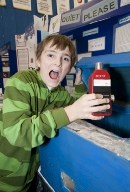Local students cleaned up last weekend at an Edmonton science fair with the help of some brains, Wi-Fi and bagpipes.
Two St. Albert and one Westlock student won top honours Sunday at the Edmonton Regional Science Fair. They were among some 300 students in grades 4 to 12 that gathered at the Northern Alberta Institute of Technology to strut their scientific skills.
These annual fairs teach students valuable problem solving and speaking skills, says event spokesperson Sue Chapotelle, and give a lucky few the chance to go on to nationals.
This year's experiments featured the effects of rock music on gerbils, the use of E.coli to detect poison, the measurement of lightspeed with chocolate and much, much more.
"There's one [exhibit] down there that involves cancer research," Chapotelle notes, "which at the high school level is quite mind-blowing."
Make some noise
One eardrum-blowing experiment was performed by Nicholas Silver, a student at St. Albert's Sir Alexander Mackenzie School. His "Quiet Please!" project won first place in the Grade 6 category.
"My sister and I both play noisy instruments," says Silver, 11 — the trumpet and the bagpipes, respectively — which makes for a huge racket when they both practice at once. He wanted to find the best way to insulate the rest of the house from their music.
Silver built a double-walled wooden box with a window in it and filled the gap with one of four types of insulation: cellulose, QuietZone, Styrofoam, fibreglass, dirt and sand. He put a decibel meter in the box, closed it, stepped back one metre, and then made some noise — a lot of noise.
Sound sources included bagpipes, a trumpet, smoke alarm, car horn, stereo on full blast and hammer hitting steel, he says. The loudest sound was the car horn at 109 decibels, which can cause hearing damage with extended exposure. He then checked the decibel meter to see how well the insulation worked.
Silver says he'd thought the solid Styrofoam would be the best insulator, but it turned out to be cellulose. "Since the cellulose is fluffy, the sound wave was chopped up to go through the different holes so it wasn't as direct," he theorizes. This information should come in handy for the music shed his parents plan to build in the near future, he notes.
Brains and waves
Fellow SAM student Alyson Katerenchuk's experiment asked, "Can a back massager improve brain power?" It placed first in the Grade 4 category.
Katerenchuk, 9, says her original experiment focused on something called The Zinger — a claw-like device that was supposed to improve brain function by stimulating acupuncture points. She decided to test the device against video games, exercise and doing nothing.
Katerenchuk had a group of nine- to 13-year-olds try to memorize one of two passages from Shakespeare's Twelfth Night before and after one of the treatments. Most of the treatments had no noticeable effect on recall.
The exception was a two-minute treatment with a back massager — every student could recall significantly more words afterward. She concluded that such massages could improve your memory, at least temporarily. "It gets the tension out of the back and relaxes them," Katerenchuk explains, which may make it easier for them to study.
A back massager could help a student if used before a test, she says, but she wasn't sure if teachers would allow it. As for The Zinger, it doesn't help her at all. "It just scratches my head."
Taking first in the Senior Life Sciences category and advancing to nationals is Kyle Schole, a student at Westlock's Richard F. Staples Secondary School. This will be his fifth time at nationals, he says.
Schole, 17, says he got the idea for his latest project after his family got wireless Internet at their house. Having heard mixed reports on the health impacts of Wi-Fi, he decided to do an experiment.
Schole placed samples of bacteria from his mouth on Petri dishes and placed them at various distances from an active Wi-Fi router for 24 hours, along with one dish in a Wi-Fi free zone as a control.
"As you get closer to the Wi-Fi router," he found, "there is considerably less bacteria growing."
This suggests that the Wi-Fi might affect bacteria in humans, leading to possible health effects.
But he only saw effects after a day of exposure, he adds, and only when the dishes were within five feet of the router. "The chances of imminent danger are pretty low, but sleeping right next to your Wi-Fi router is not recommended."
Full results are available at www.ersf.ca.




